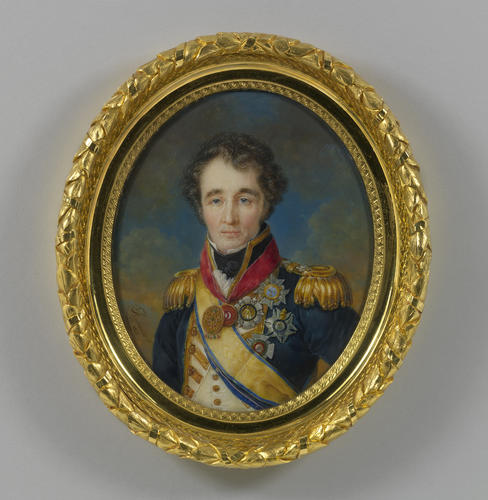-
1 of 253523 objects
Admiral Sir Sidney Smith (1764-1840) Signed and dated 1823
Watercolour on ivory | 12.7 x 10.9 cm (frame) (frame, external) | RCIN 420861

Louis-Marie Autissier (1772-1830)
Admiral Sir Sidney Smith (1764-1840) Signed and dated 1823
-
Admiral Sir Sidney Smith (1764-1840) began his career in the navy in 1777 when he was 13 years old and fought in the American War and later in the Mediterranean. In 1794, he was given command of the frigate Diamond and with a flotilla of small craft operated off the French coast. He was captured in 1796 off Le Havre and imprisoned in the Temple in Paris. Two years later, he escaped and returned to command the Tigre in the Levant (the eastern Mediterranean). The most famous episode in his career came in 1799 when he undertook the defence of Acre and repulsed Napoleon, his courage and determination inspiring the defenders. He received the thanks of both houses of parliament and in 1801, was awarded a pension of £1,000 a year. From the sultan, he received a pelisse (a fur-trimmed jacket) and his imperial aigrette, or plume of triumph, like that awarded to Nelson. He spent the last years of his life in Paris and is buried in the Père Lachaise cemetery there.
The jewel that Sir Sidney is wearing is ‘the Templar’s Cross’, which he believed had been worn by Richard the Lionheart during the Crusades. It was probably made in the eighteenth century, however, and is recorded in the possession of the convent of the Order of St. John of Jerusalem in Paris. In his will Sir Sidney ‘gave and bequeathed unto the Order of the Templars to be kept in deposit in the treasury thereof, from whence it originally came into King Richard’s hands, and to be worn by the Grand Master in perpetuity’. (Addison, C. G., MacOv, R., The Knights Templars & the Complete History of Masonic Knighthood, 1997, p. 554.) The Archbishop of Cyprus had given it to him in recognition of his having saved the islanders from destruction by insurgents in 1799.
In his portrait, Sir Sidney is wearing admiral's uniform, the ribbons of the Sword of Sweden and the Turkish Crescent and the stars of St Ferdinand (Naples), the Sword (Sweden), the Tower & Sword (Portugal) and the KCB (Knight Commander of the Bath) (UK). For another version of the miniature in the Musee Cognac Jay Paris, see B. Pappe, Autissier et le portrait miniature romantique en Belgique, 1995, p. 160.
Louis-Marie Autissier (1772-1830) was born in Vannes in Brittany. He joined the French revolutionary army at Rennes in 1791. When he left the army in 1795, he went to Paris where he trained by studying paintings at the Louvre. He settled in Brussels in 1796 and exhibited in Brussels, Paris, Amsterdam and Antwerp between 1801 and 1830. He was appointed miniature painter to Louis Napoleon, the French king of the Netherlands, in Amsterdam in 1806, court painter to Willem I, king of the Netherlands in 1815, and to Louis XVIII in Paris in 1818. He is considered the founder of the Belgian school of miniature painting in the nineteenth century.
The miniature is signed and dated along the left edge: Autissier pt. / Paris 1823. On the back are various numbers and a dealer’s or auction room entry: Admiral Sir Sydney Smith, by E. Autissier, Paris 1823.
Provenance
First recorded in the Royal Collection in 1910
-
Creator(s)
-
Medium and techniques
Watercolour on ivory
Measurements
12.7 x 10.9 cm (frame) (frame, external)
Category
Object type(s)